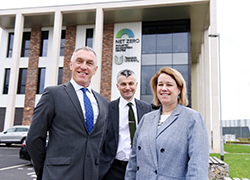Teesside Graduate receives top forensic award
A Teesside University graduate has been awarded a prestigious forensic science award for his ground breaking research looking at the links between fireworks and gunshot residue.
Matthew Grima, who lives in Malta, was presented with the Forensic Science PW Allen Award from the Forensic Science Society, at a special ceremony in Manchester this week (November 7).
The award is presented annually to the best or most meritorious paper published in the Forensic Science Society journal ‘Science and Justice’. On winning the award, Matthew said: 'It hasn’t really sank in yet, to be honest it was a total shock when I received the news. 'When you carry out research, it is already an immense feeling when reviewers approve it for publication as it highlights that your work is innovative and contributes in one way or another to the chosen field.
'This award has been won by so many established forensic experts and researchers over the years, it feels great to be recognised for making a contribution alongside them.' Matthew, achieved a first class BSc (Hons) Applied Science and Forensic Investigation at the University, followed by a Master of Research in Science.
Dean of the School of Science & Engineering, Professor Simon Hodgson, said: 'This is fantastic news for Matthew and great recognition of his research and contribution to forensic investigation.
'The courses provided and research carried out at Teesside University means that we are leading the way in forensic science and we now have an established reputation as a leader in the forensics field.'
Matthew received the award for his research which looks to see if particles generated during a firework display are similar to those found in gunshot residue and if so, could this possibly contaminate evidence found at crime scenes, possibly jeopardising the outcome of an investigation.
The work looks at the misidentification of gunshot and fireworks residue, methods to avoid such misidentification and suggestions for contamination control for police officers and support crews at fireworks display sites. Matthew first started to compare gunshot residue with fireworks particles when researching for an essay at the University in 2009.
Matthew added: 'This research is particularly significant to Malta as it has one of the highest numbers of fireworks displays in the world. Although the population is 412,000, there are 90 religious and spiritual feasts between June and September, with most of them holding their annual fireworks display.
'I have loved fireworks since I was very young, I grew up near one of the biggest display sites in Lija and being Maltese, I am used to the constant fireworks on the island, which run every weekend on most days of the week during the three summer months.'
 International partnership signed with prestigious American
...
International partnership signed with prestigious American
... Teesside University academics join prestigious network of
...
Teesside University academics join prestigious network of
... Curatorial studies culminating with international art
...
Curatorial studies culminating with international art
...